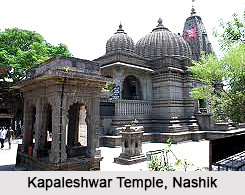 Kapaleshwar Temple is among the very oldest temple in Nashik which was built in the 14th Century. It is located to the east of Ramakund, Panchavati at Nashik in the Indian state of Maharashtra. One of the ancient Lord Shiva temples on the banks of Godavari River in Nashik is well known as "Lord Kapaleshwar Mahadev Temple". This is a fabulously built shrine found on the peaceful environment. The temple is very peculiar because there is not Nandi Bull in front of the Shivalingam, which is very rare. At every Monday there is a Puja at Ramakund Ganga ghat of Shree Kapaleshwar Mandir. Many peoples come for Darshan in this temple daily.
Kapaleshwar Temple is among the very oldest temple in Nashik which was built in the 14th Century. It is located to the east of Ramakund, Panchavati at Nashik in the Indian state of Maharashtra. One of the ancient Lord Shiva temples on the banks of Godavari River in Nashik is well known as "Lord Kapaleshwar Mahadev Temple". This is a fabulously built shrine found on the peaceful environment. The temple is very peculiar because there is not Nandi Bull in front of the Shivalingam, which is very rare. At every Monday there is a Puja at Ramakund Ganga ghat of Shree Kapaleshwar Mandir. Many peoples come for Darshan in this temple daily.
Legend of Kapaleshwar Temple
Kapaleshwar Temple has a legend associated with it. The story behind it is that once Lord Shiva by mistake killed a cow which is called "Gohatya" in Hindu mythology. In order to free from this sin Nandi told him to go to Nashik and take a bath in "Ramakund". As per Nandi"s instruction, Lord Shiva went to Nashik and cleaned his sin by taking a bath in Ramakund. Thereafter he had chanted some mantra where the temple is currently located.
Significance of Kapaleshwar Temple
Every temple of Lord Shiva has a Nandi who is the vehicle of the Mahadev but this temple has a unique feature that it does not have a Nandi. It is believed that because Nandi suggested Lord Shiva, the ways to clean his sin of killing a cow and so he considered Nandi as his "Guru" and therefore this temple has no Nandi.
Nearby Attractions at Kapaleshwar Temple
There are also "Shree Ganesh Temple", "Maruti Temple" and "Gayatri Devi Temple" near Kapaleshwar Temple. Although there are many attractions near the temple but one of the attraction inside the temple is Ramakund where Lord Shiva took bath after making a sin of killing a cow and it is believed that for every individual it is recommended to take a bath once there in Ramakund to evade from his sins.
How to Reach Kapaleshwar Temple
The temple is 1 km from the central bus station of Nashik. To reach the city centre there is an availability of buses, rickshaws and taxis. The nearest airport from Nashik is about 175 km away in Mumbai which is both domestic and international. Cabs can be hired from the airport to reach Nashik. Nashik has a well connected railway station on the central railway station.





















